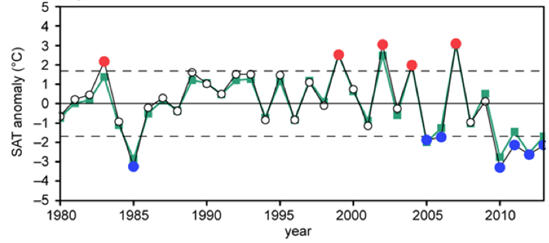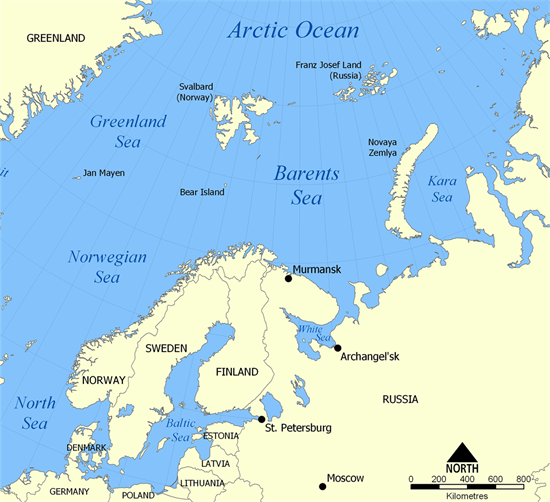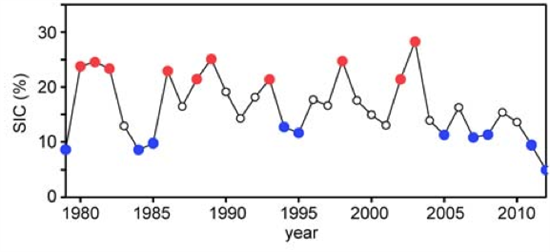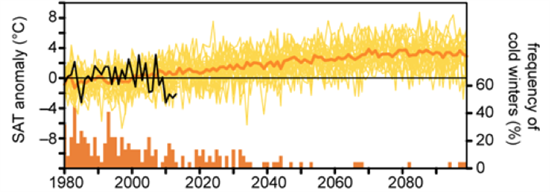Robert McSweeney
26.10.2014 | 7:11pmDeclining Arctic sea-ice has made severe winters across central Asia twice as likely, new research shows. The paper is the latest in a series linking very cold winters in the northern hemisphere to rapidly increasing temperatures in the Arctic.
But the long-term picture suggests these cold winters might only be a temporary feature before further warming takes hold.
Arctic amplification
Temperatures in the Arctic are increasing almost twice as fast as the global average. This is known as Arctic amplification. As Arctic sea-ice shrinks, energy from the sun that would have been reflected away by sea-ice is instead absorbed by the ocean.
Arctic amplification has been linked with very cold winters in mid-latitude regions of the northern hemisphere. The UK, the US and Canada have all experienced extreme winters in recent years. Just last year, for example, the UK had its second-coldest March since records began, prompting the Met Office to call a rapid response meeting of experts to get to grips with whether melting Arctic sea-ice could be affecting British weather.
The new study, published in Nature Geoscience, suggests the likelihood of severe winters in central Asia has doubled over the past decade. This vast region includes southern Russia, Mongolia, Kazakhstan, and northern China. And it’s the Arctic that’s driving the changes once again, the authors say.
Pronounced change
The study finds that almost all of the very cold winters in central Asia during the past decade have coincided with particularly warm conditions in the Arctic.
The paper points to sea ice loss in the Barents Sea and the Kara Sea as the cause. These sit to the north of Scandinavia and Russia and to the south of the Arctic Ocean, as shown in the map below.
Map showing location of Barents Sea and Kara Sea. Creative Commons
The researchers found a ‘pronounced change’ towards very low sea ice concentration in the two seas since 2004. You can see this in the series of blue dots in graph below.
Sea-ice concentration in the Barents and Kara seas, expressed as a percentage. Blue and red dots indicate low- and high-ice years, respectively.
The years with very low sea-ice coincide with very cold winter temperatures recorded in central Asia, as you can see in the graph below.
 Surface air temperatures over the Barents and Kara seas during winter, compared to the 1979-2013 average. Blue and red dots indicate severely cold and warm winters, respectively.
Surface air temperatures over the Barents and Kara seas during winter, compared to the 1979-2013 average. Blue and red dots indicate severely cold and warm winters, respectively.
Done deal
How could this loss of sea ice in the Arctic be affecting mid-latitude winters?
One theory is that the warm Arctic could be influencing the jet stream – a band of fast-flowing air high up in the atmosphere.
Professor Jennifer Francis, from Rutgers University in the US, explains:
“The idea is that ice loss in this area tends to create a wavier jet stream pattern, which causes colder winters in central Asia and blocking patterns that make this weather regime very persistent.”
Arctic links to weather patterns further south is a very new area of research. There is relatively little data to work with as Arctic amplification only emerged as a strong signal in the mid-1990s. However, Francis thinks the amount of evidence is beginning to stack up:
“Based on this new solid and convincing work, along with the others that support the existence of this mechanism, I think we can call it a done deal.”
Temporary phenomenon
So what does that mean for mid-latitude winters in the future?
Despite Arctic sea-ice loss making cold winters more likely, scientists suggest this will be outweighed by winters getting warmer as global average temperature rises.
As Dr James Screen of Exeter University explains:
“As more Arctic sea ice is lost in the future, the warming of the Arctic region gets larger. This warming spreading from the Arctic is large enough to offset (and exceed) any cooling related to change in atmospheric circulation in the long-term.”
The authors of the study agree, saying:
“The frequent occurrence of cold winters may be a temporary phenomenon in a transitional phase of eventual global warming.”
You can see this in the graph from the new paper below. The orange line shows the projected temperature change over central Asia, while the orange bars beneath show the projected frequency of severe winters. Cold winters gradually diminish as temperatures rise through the century.
Average projection of winter surface air temperatures over central Asia (orange line) and the frequency of cold winters (orange bars) for the 21st century. Yellow lines show individual results from different climate models, and the black line shows observed temperatures to the present day.
While the influence of Arctic sea-ice on weather much further south is an intriguing prospect, the new research suggests a warming world looks likely to be more of a factor in mid-latitude winters.
So while we can still expect to see severe winters in the short-term, they’re likely to be a lot less frequent in the future.
Mori, M. et al. (2014) Robust Arctic sea-ice influence on the frequent Eurasian cold winters in past decades, Nature Geoscience, doi:10.1038/ngeo2277




